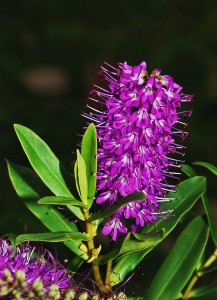Hebe is a genus of plants native to New Zealand, Rapa in French Polynesia, the Falkland Islands, and South America. It includes about 90 species and is the largest plant genus in New Zealand.
The genus is named after the Greek Goddess of youth, Hebe. There are differing classifications for the genus and some botanists include Hebe, together with the related Australasian genera Chionohebe, Derwentia, Detzneria, Parahebe, Heliohebe and Leonohebe, in the larger genus Veronica (hence its common name ‘Shrubby veronica’).
Hebe has four perpendicular rows of leaves in opposite decussate pairs. The flowers are perfect, the corolla usually has four slightly unequal lobes, the flower has two stamens and a long style. Flowers are arranged in a spiked inflorescence. Identification of Hebe species is difficult, especially if they are not in flower. The plants range in size from dwarf shrubs to small trees up to 7 metres, and are distributed from coastal to alpine ecosystems. Large-leaved species are normally found on the coast, in lowland scrub and along forest margins. At higher altitudes smaller-leaved species grow, and in alpine areas there are whipcord species with leaves reduced to thick scales.
Hebe’s are grown in many gardens and public areas; they attract butterflies. Hebes cope with most soil types, and can be propagated easily from both seed and cuttings. Wild Hebe hybrids are uncommon; however, there are many cultivated hybrids, such as Hebe × franciscana.
The Hebe Society, formed in 1985 under the auspices of the Royal Horticultural Society, promotes the cultivation and conservation of hebes and other New Zealand native plants.





